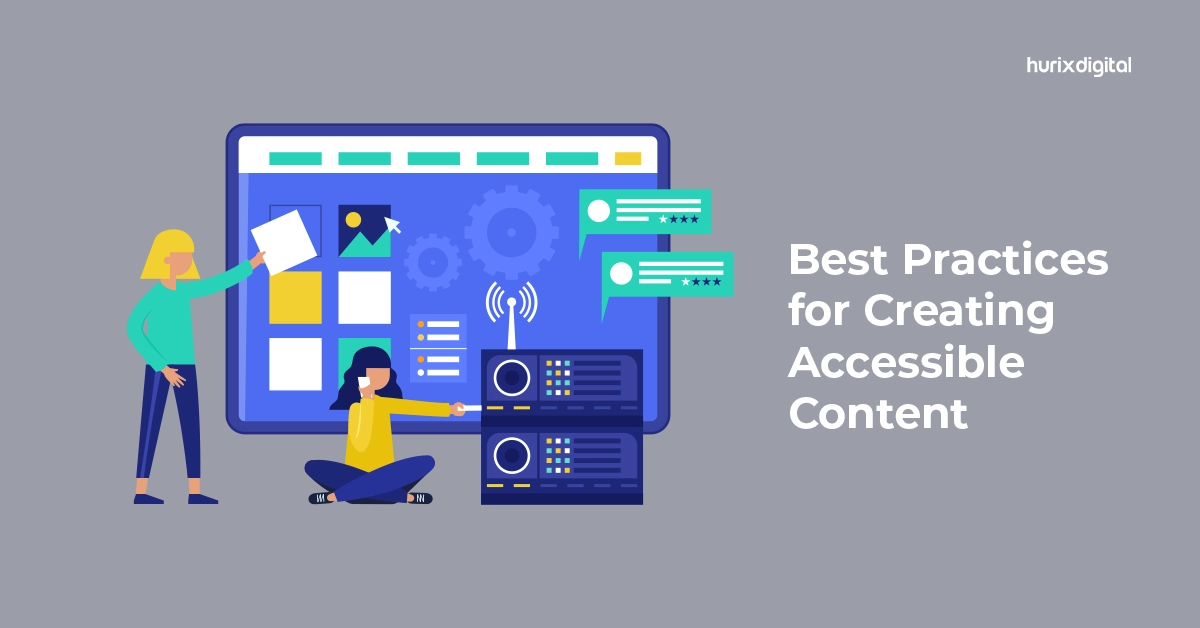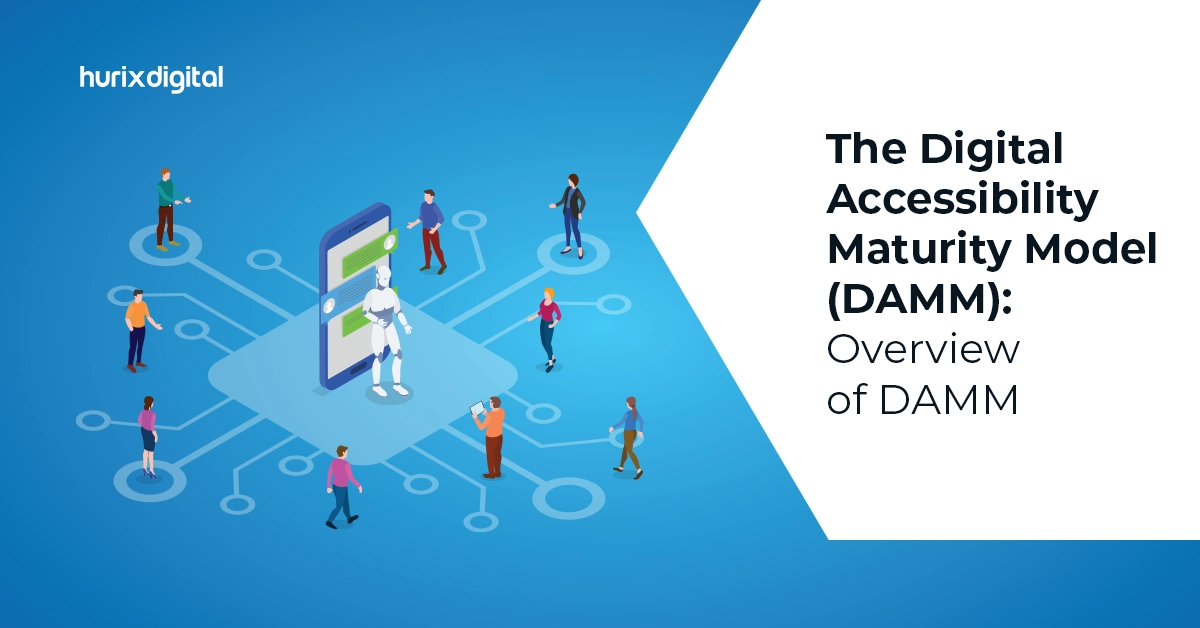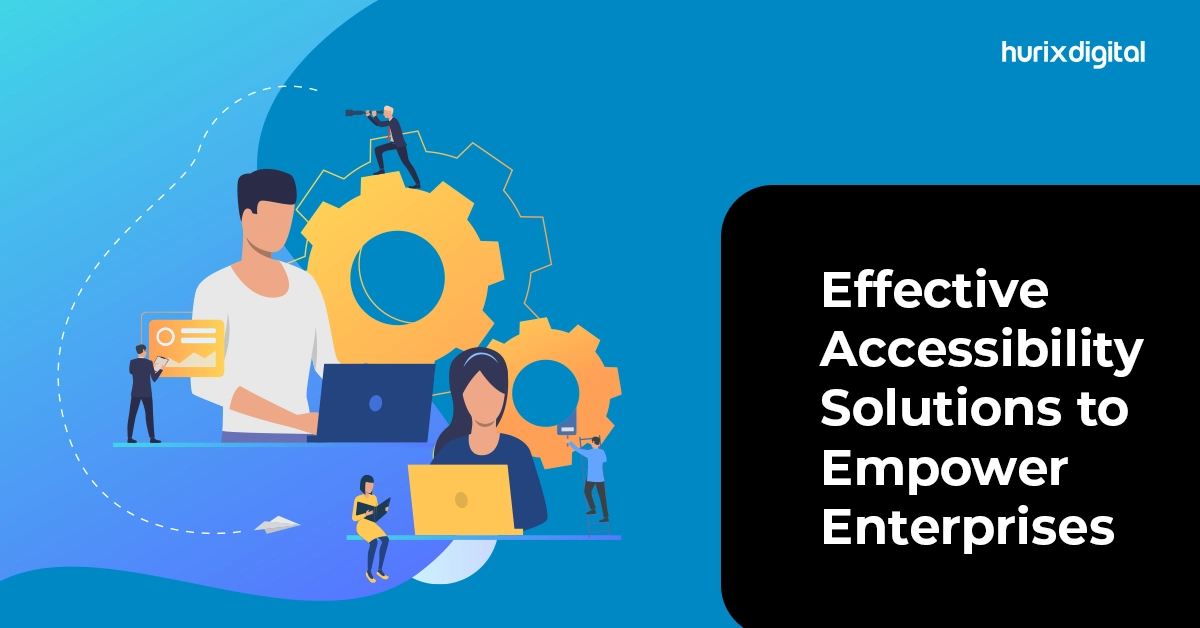
Best Practices for Creating Accessible Content
Summarize with:
Every second, three websites are published on the internet. However, did you know that 4.8% of these home pages have some accessibility error?
Since the number of digital assets has exploded, the focus is shifting towards web accessibility. How, you may ask?
Thoughtful and accessible digital content creation has strategic and tactical significance. It nurtures the customer journey at every stage, boosting your business’s bottom line. But what is inclusive content, why does it matter, and how to adhere to W3C Web Content Accessibility Guidelines?
Stay with us as we put digital accessibility under the microscope. We will examine the complex nuances of online accessibility regulations and best practices.
Table of Contents:
- What is Web Accessibility?
- Why Web Accessibility Matters?
- How to Make Your Digital Content Creation More Inclusive?
- Conclusion
What is Web Accessibility?
Web accessibility refers to digital content creation practices that make it usable for every user. Thus, visitors with visual impairments or cognitive disabilities have a seamless experience.
Prioritizing online accessibility regulations ensures the content reaches and resonates with every user – irrespective of their disability.
Also Read: 7 Reasons Why You Must Consider Web Accessibility Solutions
Why Web Accessibility Matters?
One in six people on the planet has some form of disability. They will perceive and comprehend your content differently. That’s where digital accessibility becomes the guiding post.
Digital accessibility is not just for legal compliance. Inclusive digital content plays a critical role in creating a streamlined user experience.
Let’s examine the benefits of adhering to W3C web content accessibility guidelines:
1. Expand to the Untapped Market
Around 1.3 billion people globally live with disabilities. This means there’s a relatively untapped market. Digital accessibility allows you to tap into a sizable demographic and expand your reach to new markets.
2. Inclusive Content: Information for All
Besides tapping into a significantly unexplored market, the benefits of web accessibility go beyond financial growth. Creating accessible content is vital to ensure every user can easily comprehend the content. This allows people with disabilities to understand and interact with your content.
3.Improved SEO = Increased Traffic
For any website, featuring in the top slot of SERP is paramount. While several factors do the job, web accessibility is crucial in pushing your site to the top. Following W3C web content accessibility guidelines can drastically improve SEO efforts.
How, you may ask?
Descriptive page titles, proper alt text, and semantic HTML allow search engines to crawl through the content easily. This gives your website the required traction, bringing in more traffic.
4. Web Accessibility: Improves Competitive Edge
With six websites uploaded every second, the internet is becoming a saturated space. To stand out in the competition, accessible digital content creation is pivotal.
However, most websites have accessibility barriers that can significantly impact the user experience. An inclusive website builds a streamlined interactive experience across a larger user base.
How to Make Digital Content Creation More Inclusive?
Inclusive content is not just about following online accessibility regulations! It is more about making the user feel connected and included when interacting with the content.
For example, when you include alt text, choose simple language that even a 5th grader can understand. This helps screen readers deliver a seamless experience.
Making content compliant with digital accessibility standards is a long-term process. A lot goes into creating content that’s accessible to all.
Below, we have listed down the best practices to make your digital asset more inclusive:
1. Readability Is Crucial
Think comprehensively about your audience while creating content. Therefore, your writing should be clear and concise for everyone, even for people with cognitive impairments.
We recommend using simple language. Avoid region-specific slang or heavy technical jargon.
The solution: Remember the K.I.S.S principle – keep your sentences simple and short.
Here are a few things to consider:
- Don’t exceed the magic number of “20.” Keep the sentences short, i.e., less than 21 words. Anything more than 21 words makes the sentence difficult to read and understand.
- Trying to cramp multiple thoughts in a sentence is a big No.
- Limited font variations are great for reducing cognitive overload.
- Besides, try to avoid bold text. Rather, italics or underlining to make the content more understandable for people with dyslexia or vision impairments.
- Maintain sufficient contrast between fonts and background colors. This helps users with visual difficulties, like color blindness, read the content.
2. Inclusive Graphics
Do you know one-third of website images have missing, questionable, or repetitive alt text?
Poor visual accessibility makes it difficult for people with low vision or color blindness to interact with the content.
Thus, it becomes important to include alt text properly, allowing assistive technology to read and understand the image.
Here are our top tips to ensure visual accessibility:
- Include descriptive alt text for images so screen readers can understand the content.
- If possible, avoid relying on visual elements like infographics to convey critical information. Always include alt text for visuals and textual references to make content readable for assistive technology.
- For alt text, use 125 or less characters. If the character limit is exceeded, screen readers might be unable to read the complete description.
- Don’t include alt text that is vague or repetitive.
3. Video Accessibility
Video content is gaining momentum, thanks to social media apps like TikTok or YouTube. However, most videos miss out on a critical aspect – accessibility. Users with visual or hearing impairments might be unable to understand the information.
So, what’s the solution?
Let’s see how to make the videos comprehensible for everyone:
- For an enhanced audio and video content experience, making the right choice of colors is crucial.
- Avoid flashing effects in the videos. This allows people with photosensitivity or epilepsy to consume the content.
- Incorporate closed captions and audio transcripts as it makes the video accessible for people with hearing impairments.
- Moreover, transcripts are excellent for video and audio content and are useful for people with visual and hearing disabilities.
4. Social Media Accessibility
Social media has become integral to digital marketing campaigns. Thus, making social media accessible and understandable becomes necessary. Doing so ensures a smooth customer journey experience for users with disabilities.
Here’s what you can do to make your social media profile intelligible for people with disabilities:
- Include alt text for images on social media. All the major platforms, such as Twitter, Facebook, and Instagram, offer this functionality.
- Emojis add a fun element to a social media post. However, use them wisely to make the post graspable for everyone, regardless of physical or cognitive disabilities.
- If you are posting GIFs, make sure there’s a time window between each frame. This benefits people with cognitive disabilities, who can get the most out of the content.
- Make sure your social media videos have closed captions or a voiceover.
Also Read: A Closer Look at WCAG 2.2: The Future of Web Accessibility
Conclusion
Accessible digital content is vital to staying competitive in today’s rapidly digitizing world. Following online accessibility regulations is the first step to creating inclusive content and reaching a larger user base.
Partner with Hurix Digital to enhance web accessibility and deliver intuitive user experience across a wider audience. So what are you waiting for? Contact our experts to learn about our services.
Summarize with:

Vice President – Content Transformation at HurixDigital, based in Chennai. With nearly 20 years in digital content, he leads large-scale transformation and accessibility initiatives. A frequent presenter (e.g., London Book Fair 2025), Gokulnath drives AI-powered publishing solutions and inclusive content strategies for global clients
 A Space for Thoughtful
A Space for Thoughtful 



